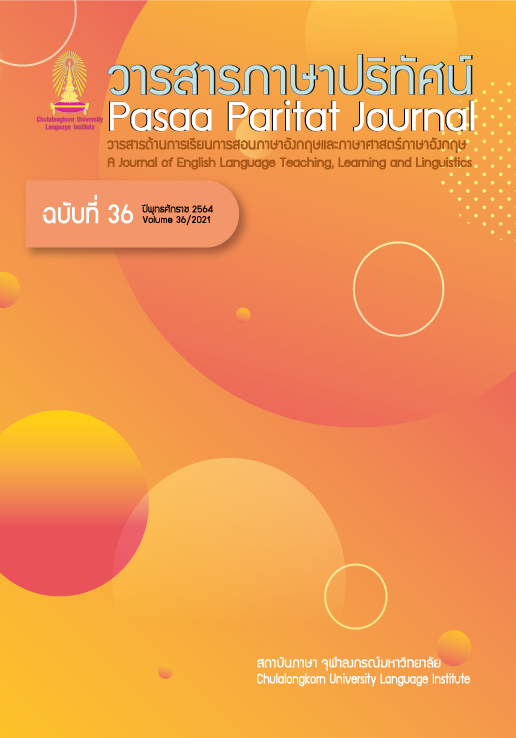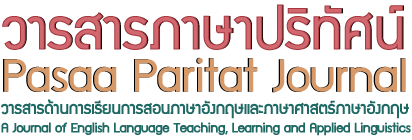The WebQuest Learning Approach and Reflective Practice in Instruction: Does It Work?
DOI:
https://doi.org/10.58837/CHULA.PPJ.36.1คำสำคัญ:
WebQuest Learning Approach, ReflectivePractice, EFL, CriticalReadingบทคัดย่อ
This study investigated the effectiveness of an instructional model integrating the WebQuest Learning Approach (WQLA) and Reflective Practice (RP) in enhancing the critical reading ability of university students. The participants were 11 second-year undergraduate students who were purposefully selected from one private university located in Phnom Penh, Cambodia. This study was a one-group pretest and posttest design. The instruments used in this study were 1) the instructional model integrating WQLA and RP, and 2) an English critical reading ability test. The instructional model was developed by integrating two learning approaches, WQLA and RP. The English critical reading ability test was developed on the basis of critical reading abilities, namely, making inferences, evaluating information, and drawing conclusions. A Wilcoxon Signed-Ranks test was used to analyze the effectiveness of the instructional model in enhancing the students’ critical reading ability. The findings showed that the students’ critical reading ability was significantly improved (p<.00). This study also sheds new light on the current knowledge, theory, and practice with respect to the effectiveness of the instructional model integrating WQLA and RP in enhancing students’ critical reading ability, in terms of making inferences, evaluating information, and drawing conclusions.
เอกสารอ้างอิง
Ahmed, M. A. E. A. S. (2016). Web Quest and EFL critical reading and writing.
Cultural and Religious Studies, 4(3), 175-184. doi:10.17265/2328-2177/2016.03.003
Aydin, S. (2015). WebQuests as language-learning tools. Computer-Assisted Language Learning, 29(4), 765–778.
doi:10.1080/09588221.2015.1061019
Canniford, L. J., & Fox-Young, S. (2015). Learning and assessing competence in reflective practice: Student evaluation of the relative value of aspects of an integrated, interactive reflective practice syllabus. Collegian, 22(3), 291–297. doi: http://dx.doi.org/10.1016/j.colegn.2014.04.003
Combs, R. (1992). Developing critical reading skills through whole language strategies. Retrieved from ERIC database (ED 353 5556)
Crawley, S. J., & Mountain, L. (1995). Strategies for guiding content reading (2nd ed.). Pearson.
Cronbach, L. J., & Snow, R. E. (1981). Aptitudes and instructional methods: A handbook for research on interactions. Irvington.
Dewey, J. (1938). Experience and Education. Collier Books.
Dodge, B. (1995). WebQuests: A technique for Internet-based learning. Distance Educator, 1(2), 10-13.
Dodge, B. (2001). FOCUS: Five rules for writing a great WebQuest. Learning and Leading with Technology, 28(8), 6-9.
Garrigus, R. (1999). Design in reading: An introduction to critical reading. Allyn & Bacon.
Khodary, M. M., & AbdAllah, M. M. (2014). Using a WebQuest model to develop critical reading achievement among languages language and translation department students at ARAR college of education and arts. International Interdisciplinary Journal of Education, 3(11), 247-256.
Lamb, A., & Teclehaimanot, B. (2005). A Decade of WebQuests: A Retrospective. Educational Media & Technology Yearbook, 30, 81-101.
McGregor, D., & Cartwright, L. (2011). Developing reflective practice: A guide for beginning teachers. McGraw-Hill Education (UK).
Mohammed, M. M. K. (2014). The effect of using s WebQuest model to develop critical reading performance among general secondary stage students in Egypt. Retrieved from https://southvally.academia.edu/ManalKhodary
Orvis, K. L., & Lassiter, A. L. R. (2007). Computer-supported collaborative learning: Best practices and principles for instructors. Information Science Publishing.
Osterman, K. F., & Kottkamp, R. B. (1993). Reflective practice for educators. Corwin Press Newbury Park.
Pirozzi, R. C., Starks-Martin, G., & Dziewisz, J. (2007). Critical reading, critical thinking: Focusing on contemporary issues. Pearson Education.
Reutzel, D., & Cooter Jr, R. B. (2015). The Essentials of Teaching Children to Read: The teacher makes the difference (6th ed.). Pearson Education.
Schon, D. A. (1983). The reflective practitioner: How professionals think inaction. Basic Books, Inc.
Schunk, D. H. (2012). Learning theories: An educational perspective (6ed ed.). Pearson Education, Inc.
Sochor, E. (1959). The Nature of critical reading. Elementary English, 36(1), 47-58. Retrieved November 16, 2020, from
http://www.jstor.org/stable/41384829
Sole, C. R. i., & Mardomingo, R. (2004). Trayectorias: A new model for online task-based learning. ReCALL, 16(1), 145-157.
Sox, A., & Rubinstein-Ávila, E. (2009). WebQuests for English-language learners: Essential elements for design. Journal of Adolescent & Adult Literacy,53(1), 38-48. doi:10.1598/JAAL.53.1.4
Sultan, Rofiuddin, A., Nurhadi, & Priyatni, E. T. (2017). The Effect of the critical literacy approach on pre-service language teachers' critical reading skills.Eurasian Journal of Educational Research (EJER)(71), 159-174.doi:10.14689/ejer.2017.71.9
Wallace, M., & Wray, A. (2016). Critical reading and writing for postgraduates: Sage.
Wilson, K. (2016). Critical reading, critical thinking: Delicate scaffolding in English for Academic Purposes (EAP). Thinking Skills & Creativity, 22, 256-265. doi:10.1016/j.tsc.2016.10.002
Zheng, R., Stucky, B., McAlack, M., Menchana, M., & Stoddart, S. (2005). Webquest learning as perceived by higher-education learners. TechTrends, 49(4), 41-49. doi:10.1007/BF02824110
ดาวน์โหลด
เผยแพร่แล้ว
เวอร์ชัน
- 2022-04-05 (2)
- 2022-03-25 (1)
รูปแบบการอ้างอิง
ฉบับ
ประเภทบทความ
สัญญาอนุญาต

อนุญาตภายใต้เงื่อนไข Creative Commons Attribution-NonCommercial-NoDerivatives 4.0 International License.



